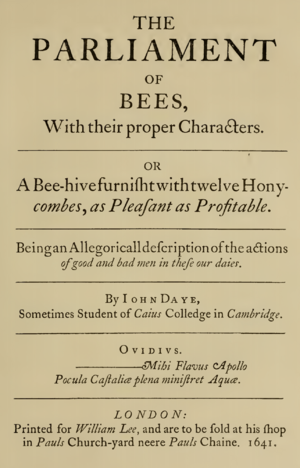John Day (dramatist) facts for kids
John Day (born 1574, died around 1638) was an English writer who created plays during the Elizabethan and Jacobean times. These periods were when Queen Elizabeth I and later King James I ruled England.
Contents
Early Life and Education
John Day was born in a town called Cawston, Norfolk. He went to school in Ely. In 1592, he started studying at Caius College, Cambridge, as a sizar. A sizar was a student who paid less for their education, often by doing some work for the college. However, he was asked to leave the college the very next year.
A Playwright's Career
After leaving college, John Day became a playwright. He worked for Philip Henslowe, who was a famous theater owner and manager. Day often worked with other writers to create plays. Some of his co-writers included Henry Chettle, William Haughton, Thomas Dekker, Richard Hathwaye, and Wentworth Smith. He is connected to about 22 different plays.
Even though he was very busy, it seems he didn't earn much money. Records show he often borrowed small amounts, like five shillings or even two shillings, from Henslowe. Not much else is known about his daily life. Some famous writers, like Ben Jonson, didn't always speak kindly of him.
John Day's Creative Works
Many of John Day's early plays are now lost. The first play he helped write was The Conquest of Brute, with the finding of the Bath in 1598.
Early Surviving Plays
One of his oldest plays that we still have today is The Blind Beggar of Bethnal Green. He wrote this with Henry Chettle. It was performed in 1600 and printed in 1659. This play was about the early years of King Henry VI. It was so popular that Day and Haughton wrote two more parts to it the next year.
In 1606, his comedy The Isle of Gulls was printed. This play was based on a famous story called Arcadia by Sir Philip Sidney. It had clever conversations and some hidden jokes about the time.
In 1607, Day worked with William Rowley and George Wilkins on The Travels of the Three English Brothers. This play told the exciting adventures of three real-life brothers: Sir Thomas, Sir Anthony, and Robert Shirley. It was a type of adventure story popular in plays back then.
In 1608, John Day published two more comedies: Law Tricks, or Who Would have Thought it? and Humour out of Breath.
The Parliament of Bees
The Parliament of Bees is often considered John Day's most important work. This play has many parts that are similar to other plays by Thomas Dekker, like Wonder of a Kingdom and The Noble Spanish Soldier. It seems that Dekker's plays might have come first, as some parts of The Parliament of Bees only make sense if you know Dekker's work. The earliest known version of The Parliament of Bees was printed in 1641.
Day's Unique Style
The six plays by Day that we still have show his unique imagination and creativity. He often used a fancy, flowery language style, similar to John Lyly. His comedies also show some influence from other writers of his time, like John Marston.
The Maid's Metamorphosis (1600) might also be one of Day's early works. It shares many of his special writing qualities. Later in his life, he wrote a prose work called Peregrinatio Scholastica or Learninges Pilgrimage. This work was printed by A. H. Bullen from Day's original writings. Some ideas from this work suggest he might have also helped write The Pilgrimage to Parnassus and Return from Parnassus.
Many people have admired John Day's work, especially The Parliament of Bees. The writer Charles Lamb praised its beauty and cleverness.
Publication of His Works
John Day's collected works were put together and edited by A. H. Bullen. They were printed in 1881. Bullen also included The Maid's Metamorphosis in his Collection of Old Plays. Other plays like The Parliament of Bees and Humour out of Breath were printed in a collection called Nero and other Plays in 1888. Arthur Symons wrote an introduction for these. A famous writer named Algernon Charles Swinburne also wrote about John Day in a magazine in 1897.
The exact year John Day died is not known. However, a poem written to honor him by John Tatham was published in 1640.
Images for kids



